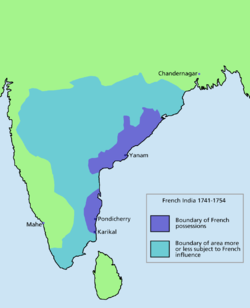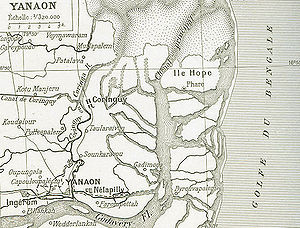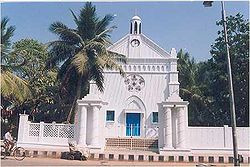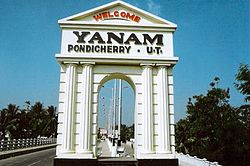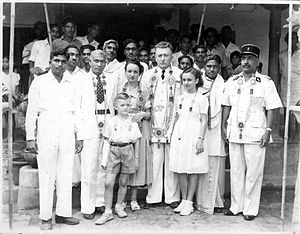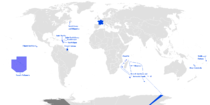- Yanam, French India
-
For Yanam after independence, see Yanam (India).
Établissement français de Yanaon French colony ← 
1816–1954  →
→

Flag Coat of arms Motto
Liberté, Égalité, FraternitéAnthem
La MarseillaiseMaximum extent of French influence (1741-1754) Capital Pondichéry Language(s) French Government Republic Historical era Imperialism - Treaty of Paris September 26, 1816 - Coup d'État June 13, 1954 Population - 1948 est. 5,853 - 1936 est. 5,220 - 1885 est. 4,266 Currency French Indian Rupee Yanam or Yanaon was a French colony between 1731 and 1954. Yanam has some 300 years of history and is well known as French Yanam after it was transferred to Indian Union in 1954.
Early years
The main colonial history of Yanam starts with early 18th century. It is mentioned in the book, The botanic garden of Yanam (Le Jardin Botanique de Yanaon) by Médecin-colonel Alfred-Alphonse-Léon Bigot (Colonel A. Bigot), that at first, the French establishment of a warehouse here in 1723 A.D. the La Compagnie des Française Indes Orientales of France established here a trading post of theirs. Since the business became slack and commercial operations had not produced the desired results, it was given up in 1727.
Dutch colony
In the west of Yanam, there are still Neelikundilu (Indigo wells). People say that the Dutch constructed a fort here.[citation needed] It is being called by locals as "saali kota" because previously weavers (Saalivandru) used to weave clothes after the exit of the Dutch. They used to keep their currency, minted in the mint at Neelapalli, in this fort.
The Dutch left Yanam before 1725.[citation needed] Some 25 kilometres (16 mi) north they used to have a colony at Jagannadhapuram (Dutch Jaggernaikpoeram, English Jagannaickpore), now in Kakinada between 1734–1795 and 1818–1825.
Inam de Bussy
This region was presented as Inam (gift) to the French general the Marquis de Bussy by Vizianagaram King Pusapati Peda Vijaya Rama Raju as a token of gratitude for the help rendered by Bussy in the fight in 1757 against the rulers of Bobbili.[citation needed] Yanam is nicknamed as Inam de bussy (Bussy's Gift).
Era of Bussy and Dupleix
Actually it was seized again by Dupleix in 1731 during the time of Pierre Benoît Dumas the then Governor General of French Establishments of India. A firman from Haji Hassan Khan, Nawab of Masulipatam authorized the French Representative Fouquet, then chief of the Company at Machilipatnam to set up a loge at Yanam in the year 1731. Nawab Roustoum khan granted a paravana dated 1735 for French commerce in Yanam. But it was re-established completely in 1742 during the reign of Mughal emperor Muhammad Shah. After 1742 political motives began to overshadow the desire for commercial gain. All factories were fortified for the purpose of defence. Mr. De Choisis administered it. He died here on 27 October 1747. Monsieur Sinfray succeeded him. The annual rent was waived off by a document in 1743 for Yanam. Mir Ahmad Ali Khan, Nawab of Arcot, granted all the rights on the lands situated before the quarters at Yanam in 1747. Unfortunately necessary details are not available for this period i.e. from 1723 to 1750. Muzaffar Jang, Nawab Subedar of the Deccan (1750–1751), confirmed the sovereignty of this territory in 31 December 1750 to the French.
Salabat Jang, the son of the Nizam al Mulk, who was indebted for his elevation to the throne to the French East India Company, granted the district of Kondavid to the French in return for their services, and soon afterwards the other Circars. A firman' was issued by the Mughal emperor, confirming all the concessions made to the French by Salabat Jang, the Subedar of Deccan. These concessions were in the shape of the donations and the name `Inam' (gift) was changed into Yanam (Yanaon) by the French in the course of time. In December 1753, a paravana of Salabat Jang, Subedar of Deccan conceded to Bussy the paraganas of Chicacole, Ellore, Rajahmundry and Mustafanagar. with an annual revenue RS.2, 00,000 for the maintenance of the French troops in the Subah in recognition of the help of these Circars amounted up to 10 lakhs of Rupees per year. Bussy helped Salabat Jang to be the Subedar of Deccan. The agreement made between the French and Salabat Jang in Aurangabad bears the signature of Said Loukshur, Minister of Salabat Jang. Yanam acquired considerable importance during the occupation of the Northern Circars by the French.
First British occupation
There is again a dearth of information regarding this place from 1753 to 1765. Another important event in the history was the war between the French and the English fought at Chandurthi in 1758 in which the French were defeated. Salabat Jang made a treaty with British and gave the Northern Circars under a firman to the English. Later Nizam rebelled against the English. A second treaty was the result of war and Northern Circars remained permanently under the control of the British. After 1760 the French lost hold in South India, especially on Northern Circars. In 1765 Lord Robert Clive, the then existing Chief and Council at Vizagapatam obtained from the Mughal emperor Shah Alam a grant of the five Circars.
A document dated 15 May 1765 showed that the villages of Yanam and Kapulapalem (Capouloupalém) with other lands were handed over by Jean white hill and George Dolben, the Englishmen deputed by Mr. Jean Pybus, the head of the English settlement in Masulipatam to Mr. Yoan Yacques Panon, French Commissioner deputed by Jean Law de Lauriston the then Governor General of Pondicherry, for taking them over. This document mentions that France entered into possession of Yanam and its dependent territories with exemption from all export and import duties. Soon after taking possession of this settlement, Mr. Panon obtained a firman from the ruler of Rajahmundry granting the French full liberty of trade at Yanam and another one from the Nawab Mir Nizam Ali Khan Bahadur (Asaf Jah II) calling upon the Zamindars of the Circar Mustafanagar not to hinder the commerce of the French.
After transfer of Northern Circars to the English, Yanam came under the province of Peddapuram in the jurisdiction of Sri Raja Vatsavaya Kala Thimma Jagapathi Bahadhoor (Timma Raja). The French had a modest building in Yanam situated a league from the sea, on the Coringa River into which small vessels could enter.
Preceded by
French East India CompanyFirst British Occupation of Yanaon
1758–1765Succeeded by
French East India Company1765 dispute of market
The documents of 1765 throw light on a dispute of a weekly market or fair in Yanam. A weekly market used to be held here on every Tuesday (Even now market occurs in Yanam on this Tuesday only). People used to come to it for purchasing all their essential commodities once for a week. Neelapalli (Nélapilly), a neighbouring village of Yanam was under the British at that time. It is nearly 3 kilometre away from Yanam. The people in this village also used to hold a fair on Tuesday. Thus there was a clash of interests between Yanam and Neelapalli. After prolonged correspondence with the English authorities at Madras, the French authorities in Yanam succeeded in changing the fair of Neelapalli to another day of the week, Saturday. In this way, Yanam triumphed over its neighbouring village Neelapalli.
1767 memoire by Lauriston
Jean Law de Lauriston, Governor of Pondicherry (1765–1766) stated in his "Memoire of 1767" as "It is from Yanam that we get our best ‘Guinness’ (fine cloth). It is possible to have a commerce] here worth more than a million livres per year under circumstances more favorable than those in which we are placed now, but always by giving advances much earlier, which we have never been in a position to do. From this place we also procured teakwood, oils, rice and other grains both for the men as well as for the animals. A port from commerce, Yanam enjoyed another kind of importance. "The advantages which may be derived in a time of war from the alliances that we the French may conclude with several Rajas who sooner or later cannot fail to be dissatisfied with the English'." Although the English gained an effective control over the Circars, Yanam enabled the French to enter into secret relations with the local chieftains. Yanam had some commercial importance".
It was a centre for the production of salt and this salt constituted the major part of the quantity imported by the French into Bengal region. It was also an important center of cotton goods and supplied a large part of the return cargo of the French ships visiting India. A few French citizens in Yanam were fully occupied by these two kinds of profitable business and they had no interest in political and administrative matters that were left entirely to the chief or commandant. Indian residents wanted nothing better than to be left in peace to carry on their trading activities.
Second British occupation
Between 1778 and 1783, Pondicherry was under British occupation. There is again lack of information because of its subsequent English occupation. Yanam was restored again to the French in 1785. Mr. Mallhendre took possession of it and Mr. Bluter succeeded him. It was recommended to them to favor the business of the French East India Company and to protect the interest of some specified merchants.
Preceded by
French East India CompanySecond British Occupation of Yanaon
1778–1785Succeeded by
French Colonial EmpireDuring the French Revolution
The French Revolution had its effects in different ways in all the former French settlements. The French trade at Yanam was considerable at that time.
After Bluter, Mr. Pierre Sonnerat became the chief in 1790 in Yanam. He was a scholar and writer. He had a profound interest in natural sciences. He wrote a book,Voyages aux Indes Orientales et à la Chine, in three volumes. He appreciated very much the sonority and the music of the Telugu language. He administered Yanam during the time of the French Revolution.
Sonnerat was involved in this business along with other traders. His commercial involvement brought serious consequences to his administrative post. The petitions were made against him in this connection, to the Chevalier de Fresne the then French Governor in Pondicherry. On 5 June 1790 a Frenchman called De Mars complained about him for the first time. By that time, Pondicherry under the influence of the French Revolution had already formed the first representative committee. But no action was taken in favor of De Mars either by the Governor or by this committee. Naturally, the French citizens in Yanam were uninterested in the affairs of Pondicherry owing to his failure.
Third British occupation
Once again French lost control over Yanam to the British. During 1793 and 1816 Pondicherry was under British control. So, Yanam fell thrice into the hands of the British. After the Napoleonic wars, by the Treaty of Paris (1814) Yanam along with the factory at Machilipatnam was finally returned to the French on 26 September 1816. From then it was continuously under the control of French until it got independence. The third British occupation is also called as final British occupation.
Preceded by
French Colonial EmpireFinal British Occupation of Yanaon
1793–1816Succeeded by
French Colonial EmpireLocal administration
1840 Decree
Local administration was started in Yanaon by a royal decree (Ordonnance Royale) dated 23 July 1840 during July Monarchy. According to that decree Yanaon and Mahé were Provided with Chef de service (Service Chief) who resides in his official residence. After the merger, it is being resided by Regional Executive Officer, Yanam.[1]
Thus a colonial government was formed in 1840. According to Annuaire statistique des établissements français dans l'Inde- 1843 by Pierre-Constant Sicé, the details of colonial government in 1843 were,
- Gouverneur Général de établissements français dans l'Inde' - De Nourquer Du Camper (Paul)
- Gouvernement Colonial de Yanaon
- Chef de service - Jourdain (Jean-Philippe-Paul)
- Administration - Ribeiro (Dominique-Grégoire), écrivain.
- Service de Santé - Pithois (Pamphile), officer de santé.
- Administration financière - Ticanny Tiramalaram, percepteur des revenues à mazulipatam.
- Justice
- Tribunal de prèmiere instance
- Sicé (Eugène), procureur du Roi
- Calmels (Jean-René-Eucher), greffier-notaire
- Vingatramaya, interprête.
- [Police
- P.Condaya, interprête.[2]
- Tribunal de prèmiere instance
- Chef de service - Jourdain (Jean-Philippe-Paul)
1871 Decree
According to a decree dated 1 February 1871, one person can be sent as a député to the Chambre des députés.[1]
1872 Decree
Another pivotal incident in local administration was decree of 1872. It was dated 13 June 1872 and was issued during Third Republic. According to that decree Conseil locaux (Local councils) were created at each colony. The elected member was called as Conseiller local (Local councillor). Conseil local de Yanaon had a strength of four local councillors. The term of office was 6 years with one half of membership renewed every three years.[1]
1878 Decree
According to a decree dated 24 February 1878, one person can be sent as a sénateur to the Sénat (French Senate). Senator will be elected by Conseil colonial (Colonial Council) and Conseil local (Local council). First election were held on 26 March 1876.[1]
1946 Decree
By the decree of 1946, French India (Inde française) became Overseas territory (Territoire d'outre-mer) of France. Then an Assemblée Représentative (Representative Assembly) was created for each colony. Yanaon was provided with two assembly representatives (Equivalent to Member of the Legislative Assembly).
Notable assembly representatives from Yanam were Kamichetty Venougopalarao Naidou, Kamichetty Savithiry, Kamichetty Sri Parassourama Varaprassada Rao Naidu and Kanakala Tatayya Naidou.[1]
Municipal administration
Main article: Municipal Administration in French IndiaThough the French established colonies in India in seventeenth century itself, it was not until during the end of 19th century they started civil administration in French India.
French Metropolitan Decree
A French Metropolitan Decree, dated 12 March 1880 adopted a six-year term of office for Mayors (Maire), municipal councillors (Conseil Municipaux) and commune panchayats (Communes). Thus French India has seen a French system of municipal administration. In the past, municipal administration was virtually the pivot of the whole administrative machinery in French India. It had several features that could serve as a role model for hassle-free administration.
Then a total of 10 communes were formed in which Yanaon became one commune with a strength of 12 Municipal Councillors (conseiller municipaux). First elections were held on 30 May 1880.
Structure of municipality
See also: Yanam MunicipalityLa Mairie (Town Hall) in Yanaon is now called as Municipality Building. It was built in 19th century and is situated next to Court House in the Thiagaraja Street in Yanaon Town. During French colonial rule, Yanam Municipality had 12 Sièges. Then, they were called previously as Sièges instead of wards. Each ward (Siège) was represented by a municipal councilor (Conseiller Municipal). Each commune possessed a Mayor (Maire) and a Municipal council (Conseil Municipal) which managed the commune from the Mairie. The life-span of a Municipal council was six years, with one-half of the membership renewed for every three years.
Election results of 1948
Elections held on 24 October 1948 and 18 October 1954 were the most crucial in the history of French India. In June 1948 the French and Indian Governments came to an agreement as to how the future of the French Settlements should be determined.
Municipal elections were held in Pondicherry, Karikal and Yanam on 24 October 1948. The two main parties were the French India Socialist Party (Socialist]), who favoured the continuance of French rule, and the French India Congress (Congress), who favoured union with India. Socialist Party was headed by Kamichetty Sri Parassourama Varaprassada Rao Naidu, a strong pro-French leader and later MLA of Yanam. and Congress Party was headed by Yerra Jaganatha Rao.[1] Among the Independents was Madimchetty Satianandam who later elected as mayor and performed a key role in merging of Yanam in India.
- Yanam - 12
- Socialists - 3
- Independents - 9
Notable Municipal Councillors were, Bezawada Bapa Naidou, Diwan Bouloussou Soubramaniam Sastroulou, Kamichetty Venougopala Rao Naidou, Samatam Krishnayya, Madimchetty Satianandam, Kamichetty Savithiry and Kamichetty Sri Parassourama Varaprassada Rao Naidu.
Cession of Yanam
Main article: Coup d'État de YanaonActually, Yanam had an extremely dominant pro-French atmosphere prevailing in its people and its leaders. But in due course of time due to nationalist struggle by some leaders, conditions became intolerable in Yanam after its mayor and other representatives of Yanam adopted the merger resolution. The mayor, deputy mayor, and over 200 people took refuge in the adjacent areas of the Indian Union. Police and hired hoodlums from Yanam assaulted refugees on Indian soil. It was then that the refugees marched into Yanam under the leadership of Dadala Raphael Ramanayya and aided by the then-Maire de Yanaon, Monsieur Madimchetty Satianarayanamourty alias Satia and took over the administration. After hoisting the Indian National Flag, they formed the revolutionary provisional government of Yanam headed by Dadala Raphael Ramanayya and adopted a resolution declaring "Yanaon A Libéré" (Yanam liberated). The coup d'état of Yanam was announced by All India Radio and Press.
Preceded by
British OccupationFrench Establishment of Yanam
(de-facto not recognized by France)
26 September 1816–13 June 1954Succeeded by
Provisional Government of YanamFrench Establishment of Yanam
(de-facto)
26 September 1816–1 November 1954Succeeded by
IndiaFrench Establishment of Yanam
(de-jure)
26 September 1816–16 August 1962]Succeeded by
IndiaAftermath of liberation
The Yanam, coup d'état (Rājyaghātuka Charya) had enraged the French authorities of Pondicherry. Rumours were spread to the effect that the French government were despatching a cruiser to Yanam to capture Merger Leaders and to re-establish their authority. After the coup, last administrator of Yanam, George Sala was recalled by André Ménard, then Governor General of Pondicherry in June 1954.
Dadala was also appointed as Acting Commisoner for Yanam for 14 days. Towards the end of June 1954, Sri Kewal singh paid a visit to Yanam and requested Dadala's return to Pondicherry to continue his activities there. On 3 July, on Kewal Singh's request, Dadala left Yanam, after making all arrangements for its proper administration.
De facto transfer
Yanam remained under French control till June 13, 1954, when it joined the Republic of India by Indian Military Action. On November 1, 1954, after long years of freedom struggle the de facto transfer (Vāstavikāntaraṇa) of the four enclaves of Pondicherry, Yanam, Mahe, and Karikal to the Indian Union occurred.
The Prime Minister, Jawaharlal Nehru had visited Pondicherry on 16 January 1955. Messrs Edouard Goubert, S. Perumal, Dadala and Sri Pakirisamy Pillai presented addresses to Pandit Nehru in a public meeting in the maidan of Gorimedu.
Treaty of Cession
A treaty of cession was signed by the two countries in 28 May] 1956. The de jure transfer was delayed until the end of the Algerian War. The treaty was ratified by the French parliament in May 1962. On August 16, 1962 (De Jure Day) India and France exchanged the instruments of ratification under which France ceded to India full sovereignty over the territories it held.
De jure transfer
Treaty of cession was signed by the two countries in May 1956 was ratified by the French parliament in May 1962. On August 16, 1962, India and France exchanged the instruments of ratification under which France ceded to India full sovereignty over the territories it held. Every year on 16 August, the De-jure Transfer Day (Vidhitāntaraṇa Dinamu in Telugu) is celebrated throughout Pondicherry Union Territory.
Merger in Pondicherry U.T.
Puducherry and the other enclaves of Karaikal, Mahe and Yanam came to be administered as the Union Territory of Pondicherry from July 1, 1963.
Date of events
Inde française Colony Liberation de-facto transfer Treaty of Cession de-jure transfer Merger Pondichéry - 1 November 1954 28 May 1956 16 August 1962 1 July 1963 Chandernagore - 26 June 1949 28 February 1951 9 June 1952 1 October] 1954 Karikal - 1 November 1954 28 May 1956 16 August 1962 1 July 1963 Mahé 16 June 1954 1 November 1954 28 May 1956 16 August 1962 1 July 1963 Yanaon 13 June 1954 1 November 1954 28 May 1956 16 August 1962 1 July 1963 Notable people in colonial period
First Laurel Poet of Andhra, Chellapilla Venkata Kavi (1870–1950), One of the duo of the famous Tirupati Venkata Kavulu lived here. Many poets such as the late Villa Reddi Naidu, V.Venkataswami Naidu. Some important politicians include Kanakala Tatayya Naidou, MD Abdul Razzaq, Majety Subbarao, and Guiry Madhavarao.
- Guiry Soubaraw (Sergent-chef)
- Bezawada Bapa Naidou
- Manga Vincanna
- Bouloussou Soubramaniam Sastroulou
- Kamichetty Venugopala Rao Naidou
- Dadala Rafael Ramanayya
- Samatam Krouschnaya
- Kamichetty Sri Parassourama Varaprassada Rao Naidu
- Manyam Zamindar
- Madimchetty Satianandam
- Guiry Tatayanaidou
See also
- Yanam Municipality
- Marquis de Bussy-Castelnau
- Pondicherry
- French India
- Causes for Liberation of French colonies in India
- Municipal Administration in French India
- Coup d'État de Yanaon
References
- ^ a b c d e f La Gazette de I'Etat de Pondichéry (Gazette of Pondicherry)
- ^ Annuaire statistique des établissements français dans l'Inde By Pierre-Constant Sicé
External links
Categories:- Former republics
- Former countries in South Asia
- Former colonies of France
- States and territories established in 1816
- States and territories disestablished in 1954
- 1954 disestablishments
- Puducherry
- History of Pondicherry
Wikimedia Foundation. 2010.

